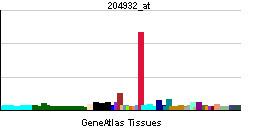Entrez 4982 | Ensembl ENSG00000164761 | |
 | ||
Aliases TNFRSF11B, OCIF, OPG, PDB5, TR1, tumor necrosis factor receptor superfamily member 11b External IDs OMIM: 602643 MGI: 109587 HomoloGene: 1912 GeneCards: TNFRSF11B | ||
Osteoprotegerin (OPG), also known as osteoclastogenesis inhibitory factor (OCIF), or tumor necrosis factor receptor superfamily member 11B (TNFRSF11B), is a protein that in humans is encoded by the TNFRSF11B gene. Osteoprotegerin is a cytokine receptor, and a member of the tumor necrosis factor (TNF) receptor superfamily.
Contents
Structure
Osteoprotegerin is a basic glycoprotein comprising 401 amino acid residues arranged into 7 structural domains. It is found as either a 60-kDa monomer or 120-kDa dimer linked by disulfide bonds.
Function
Osteoprotegerin is a decoy receptor for the receptor activator of nuclear factor kappa B ligand (RANKL). By binding RANKL, OPG prevents RANK-mediated nuclear factor kappa B (NF-κB) activation which is a central and rapid acting transcription factor for immune-related genes, and a key regulator of inflammation, innate immunity, and cell survival and differentiation. Osteoprotegerin levels are influenced by voltage-dependent calcium channels Cav1.2. OPG can reduce the production of osteoclasts by inhibiting the differentiation of osteoclast precursors (osteoclasts are related to monocytes/macrophages and are derived from granulocyte/macrophage-forming colony units (CFU-GM)) into osteoclasts and also regulates the resorption of osteoclasts in vitro and in vivo. OPG binding to RANKL on osteoblast/stromal cells, blocks the RANKL-RANK interaction between osteoblast/stromal cells and osteoclast precursors. This has the effect of inhibiting the differentiation of the osteoclast precursor into a mature osteoclast.
Regulation and therapeutic applications
Osteoprotegerin production is stimulated in vivo by the female sex hormone estrogen, as well as the osteoporosis drug, strontium ranelate. Denosumab is a pharmacologic agent that in essence acts like osteoprotegerin as a decoy receptor for osteoblastic RANKL.
Recombinant human osteoprotegerin specifically acts on bone, increasing bone mineral density and bone volume. Space shuttle flight STS-108 in 2001 tested the effects of osteoprotegerin on mice in microgravity, finding that it did prevent increase in resorption and maintained mineralization. Osteoprotegerin has been used experimentally to decrease bone resorption in women with postmenopausal osteoporosis and in patients with lytic bone metastases.
Clinical significance
Elevated OPG levels has been reported in heart diseases, in placebo effect serum responses in IBS patients (doi:10.1111/j.1365-2982.2009.01440.x PMID 20028464) and in severe mental disorders.
Mutations in TNFRSF11B are associated with osteoarthritis.
It has been found that osteoprotegerin is expressed on mesenchymal stem cells, which mediates their suppressive effect on osteoclastogenesis.
In recent years, it has been hypothesized that osteoprotegerin may be a link between bone and cardiovascular disease. It has been particularly related to the increase in cardiovascular risk in patients suffering from diabetes
